Temples in Ancient Rome held significant importance with the level of Roman Architectural skills used to build and the value they held.
The temples were spread all over the Roman cities, built differently, and meant for a different Roman deity or sometimes dedicated to more than one particular deity or an Emperor.
The Temple of Zeus was a cult built for God Zeus, and the Pantheon was dedicated to multiple deities.
Some Roman temples were even dedicated or made to honor the Emperor for their good deed.
For instance, the Temple of Caesar was built to honor Emperor Julius Caesar; likewise, the Temple of Augustus is to honor Emperor Augustus.
The magnificent temples of ancient Rome, among which only some remain perfectly preserved, were initially designed and built based on Etruscan architecture and were located in various Roman cities.
Later on, a heavy influence of Greek architecture was seen in the building of Roman temples.
From amongst the several spectacular temples that reflect the cultural and architectural aspects of ancient Rome distinctly, a description of some of these exquisite sites starts hereunder:
What was the oldest temple of ancient Rome?
Content
The Temple of Jupiter Optimus Maximus was the oldest massive Roman temple on Capitoline Hill of ancient Rome.
Which is the best-preserved Roman temple?
The Pantheon is unquestionably the best-preserved building constructed by the Romans during the ancient period.
Who were the twelve Olympians?
Who were the Vestal Virgins?
In ancient Rome, the Vestal Virgins were the priestesses who tended the Vesta Temple and the sacred fire of Vesta.
What happened during the persecution of pagans in the late Roman Empire?
Roman emperor Constantine the Great initiated the destruction of pagan temples to reconstruct the buildings as Christian churches. This period of the persecution of pagan temples in the Late Roman Empire resulted in many temples being demolished and many being converted to churches.
10. Temple of Zeus in Aizanoi
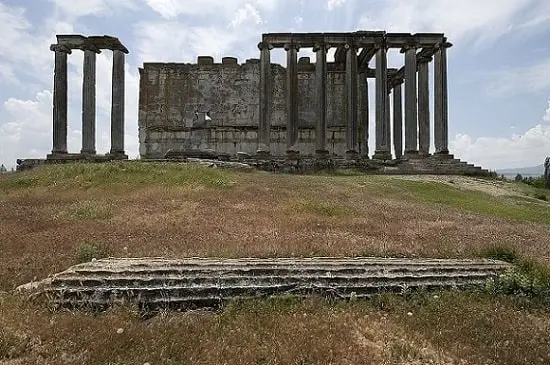
The temple of Zeus, situated in Kütahya Province, Turkey, is undoubtedly one of the best-preserved Roman temples.
The temple follows a pseudo-dipteral pattern with two peristyles surrounding it; the inner peristyle includes eight ion columns, and the outer peristyle has fifteen ion columns.
The temple is said to be the principal religious sanctuary of the city during ancient times.
The construction of the beautiful shrine started in 92 CE and continued to its completion during the 2nd century CE. Former Roman emperor Hadrian commissioned the temple’s completion.
The temple was dedicated to two deities; Zeus, the chief Greek deity, was devoted to the above-ground section. Cybele, the Anatolian mother goddess, was devoted to the underground section.
The battle scenes portrayed on the walls of the edifice date much later, representing the lives and battles fought by the Tatars in the 13th century AD.
Apart from three columns being re-erected after the destructive earthquake of 1970 AD, the temple stands tall and unaltered by modern-day construction.
9. The Temple of Vesta
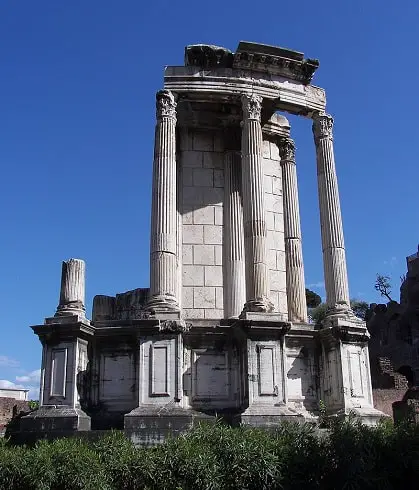
The Temple of Vesta, located in Rome, Italy, is one of the most famous monuments of the former acropolis of Tivoli.
The temple was found to be erected on a circular foundation with as many as twenty fluted columns encircling it externally through archeological studies.
The round structure of the temple, compared to the traditional rectangular design during that time, made it a unique architectural site.
The temple, which had to be rebuilt on many occasions, is said to be constructed initially during the 3rd century BCE at the time of the second king of Rome, Numa Pompilius.
The temple was located in front of the House of the Vestal Virgins and was also watched over by the Vestal Virgins who inhabited the house.
This sacred temple was built to be Vesta, a Roman goddess of the hearth, and sheltered Vesta’s holy fire.
This sacred fire was believed to be linked to the city’s fortune and safety. The entrance of the Vesta temple was constructed east-facing to emphasize the connection between the Sun and the holy fire.
As mentioned earlier, the temple was reconstructed quite a few times following its initial construction.
The first destruction occurred in 390 BC, initiated by the Celtic group, Gauls, who burned the Vesta Temple down.
Then multiple fires took place, destroying the temple repeatedly during 241 BC, 210 BC, and the early first century BC.
Eventually, it was torched again in 191 AD, which led to the final reconstruction of the Vesta Temple during the reign of the Roman emperor Lucius Septimius Severus by his wife, Julia Domna.
The Temple of Vesta stood firm from then on until the Renaissance period.
In 1549 AD, the temple was reduced to ruins, and the only remaining picture of what the actual Vesta Temple looked like came from illustrations in coins and art.
The ultimate reconstruction of the Temple of Vesta took place in 1930 AD, initiated by Alfonso Bartoli to the state that it can be seen today.
8. Temple of Portunus or Temple of Fortuna Virilis
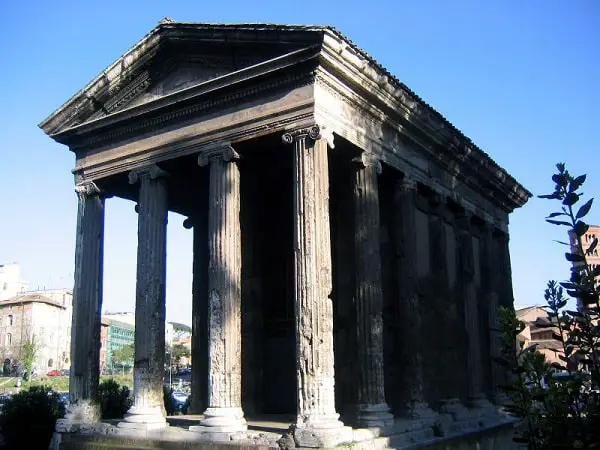
The Temple of Portunus, which undoubtedly falls on the list of the best-preserved Roman temples, lies in the city of Rome in Italy.
It was renamed the Temple of Fortuna Virilis during the Renaissance period and has been popularly known by this name ever since.
The temple was initially constructed around the 3rd or 4th century BC and was eventually reconstructed between 120-80 BC.
It is a rectangular tower raised high on a podium reached through a flight of stairs. It has six free-standing ionic columns supported by the porch, four columns across, and two deep.
In addition, there are five engaged columns on both sides and four at the rear of the building.
Although the dedication of this temple remains vague, some arguments suggest that the temple was built as a dedication to the deity Portunus, an ancient Roman god of keys, doors, livestock, and ports.
A minority view suggested that the temple was devoted to Fortuna Virilis, an aspect or manifestation of the goddess Fortuna.
The excellent preservation of the temple justifies that it was not subject to any significant reconstruction.
The primary reason behind its undefeated preservation is the re-dedication of the temple as a Christian shrine to Santa Maria Egyziaca in 872 CE.
The Temple of Portunus was included in the World Monuments Watch List in 2006, and through efforts like this, it continues to survive and flourish as a beautiful archeological site.
7. Temple of Augustus
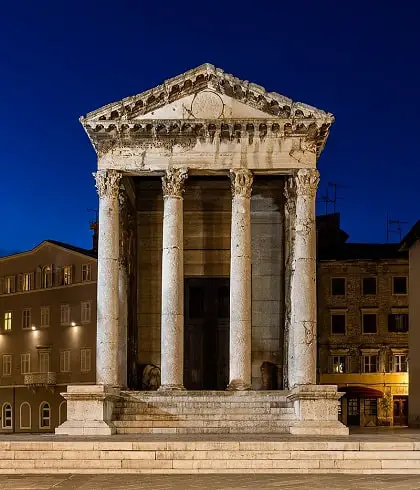
The Temple of Augustus is most certainly a well-preserved ancient Roman temple located in the largest city of Croatia, Pula.
The rectangular building stands on a high podium with prostyle Corinthian columns supported by the porch.
Initially, the temple was dedicated to Roma, a female goddess who personified the Roman state, and Caesar Augustus, the first Roman emperor.
This indication came from the dedication text affixed by nails to the stones of the architrave, though only the attachment remained.
It was a formal dedication observed in other Augustan temples and suggested that the temples were co-dedicated to the female deity.
The temple was part of a triad; a central temple with the Temple of Augustus to its left and a temple dedicated to the goddess Diana to its right.
The central temple did not live to this time, and the temple dedicated to the goddess was incorporated into the Communal Palace.
This highly accounted for its survival for a significant period until an Allied air raid in 1944 almost annihilated it. It was then reconstructed in 1947 and stood firm up to modern times.
Presently, it is in operation as a lapidarium.
6. Temple of Garni
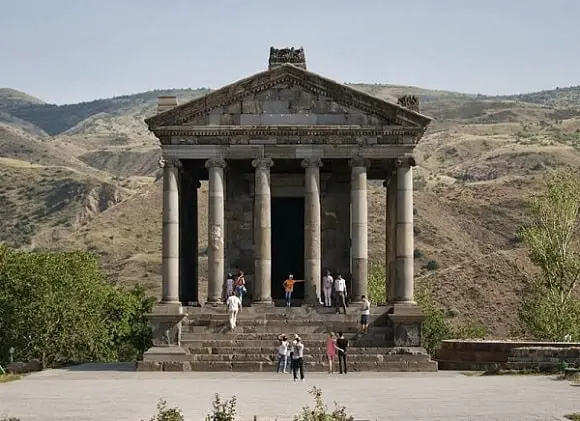
The temple of Garni is the sole free-standing Greco-Roman building in Armenia. It is situated in a significant village, Garni, in Kotayk Province.
It is a peripteros constructed on a raised platform surrounded by a colonnade of twenty-four ionic columns.
Even though the architectural elements display variation, the temple is most certainly decorated in the Imperial Roman style.
The exact date or period of the foundation of Garni Temple is unclear and subject to discussion.
A significant view suggests that the temple was built around 70-80 CE during King Tiridates I of Armenia.
Another opinion by historian Movses Khorenatsi contradicts this view and suggests the commission of the temple in the 3rd Century CE during the reign of Tiridates the Great.
The temple is supposedly dedicated to Mihr, the god of the Sun and the light of heaven. It symbolizes the profound historical relations of Armenia with the civilization of Rome.
During the rule of King Tiridates III in the early fourth century, all known pagan temples were demolished after Christianity was adopted as the state religion.
Only Garni Temple was not obliterated; the question as to why remains unanswered. The temple suffered significant destruction during the 1679 Armenia earthquake.
Though quite a few proposals for the site’s reconstruction were put forward, it was only on December 10, 1968, that the Soviet Armenian government provided the necessary approval.
The reconstruction led by the Armenian historian Alexander Sahinian ended in 1975, almost 300 years after the disaster.
Currently, the Garni Temple remains one of the major tourist destinations and a principal shrine to the Hetans.
5. The Temple of Jupiter Optimus Maximus
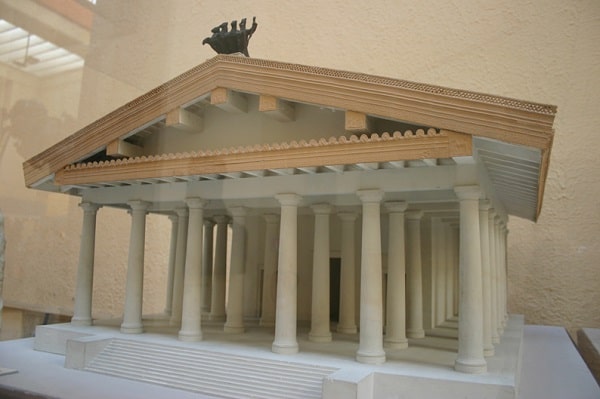
The Temple of Jupiter Optimus Maximus or the Temple of Jupiter Capitolinus was considered the most significant temple of Ancient Rome in terms of cultural impact and design.
The sanctuary in Rome, Italy, was subject to multiple destructions and reconstructions throughout its life.
According to a Roman historian, the original construction supposedly took place during the reign of Etruscan king Lucius Tarquinius Priscus.
Most parts of the foundation and framework were later completed by Lucius Tarquinius Superbus, the last king of Rome. The temple’s dedication was towards the Capitoline triad, Jupiter, Juno, and Minerva.
Each deity was said to have a separate cella with Jupiter in the middle and Juno and Minerva on the left and right.
After the first temple burned down during civil wars in 83 BC, it was reconstructed in the same foundation under the original building plan with somewhat costlier materials.
Quintus Lutatius Catulus, a Roman politician, got the chance to commission the temple in 69 BC.
Unfortunately, the reconstructed temple was subject to fire again during a fight on the hill on December 19, 69 AD.
It was then rebuilt by the new emperor, Vespasian, who built it on the same foundation with an exquisite framework.
This third building was comparatively taller and consisted of a comprehensive collection of statues, including a quadriga and bigae driving figures of Victory, the personified Roman goddess of victory.
The temple was burned down for the third time during the emperor Titus Caesar Vespasianus in 80 AD, followed by its instant reconstruction conducted by the succeeding emperor Domitian.
This time materials used for the superstructure were lavish as never before. This fourth and final tower lasted well-preserved for over three hundred years.
It was then shut down as persecution of pagans in the late Roman Empire began.
Following the persecution, the temple deteriorated and was torn down gradually until it was finally demolished in the 16th century, and a palace was built on that site.
Today, some remains and ruins of the great temple can be seen in the exhibition areas of the Capitoline Museums.
4. Sbeitla Forum Temples
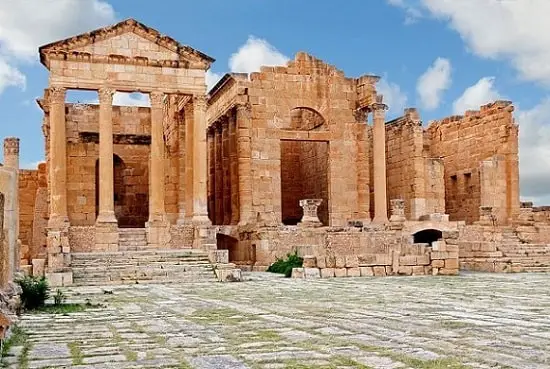
Located in one of the best-preserved Roman cities in Tunisia, the Sbeitla Forum Temples is a group of three Roman temples at a colossal square forum surrounded by a wall.
The temples were built in the 2nd century, and the prosperous olive industry is supposed to have supported this construction.
The group of temples is dedicated to the three major Roman deities, Jupiter, Juno, and Minerva.
Rather than building a single shrine dedicated to all three deities, the inhabitants constructed three separate ones devoted to each.
The central Temple of Jupiter is surrounded by comparatively smaller temples dedicated to Juno and Minerva on the right and left, respectively.
The construction plan of the temples is considerably unique. The central temple cannot be reached through a flight of stairs but only via the bridges that link it with the two temples.
These temples stand tall over the surrounding ruins in a reasonably well-preserved state.
The Sbeitla Forums Temple and whatever is left of the ancient city Sufetula are among the top tourist attractions of Tunisia.
3. Maison carrée
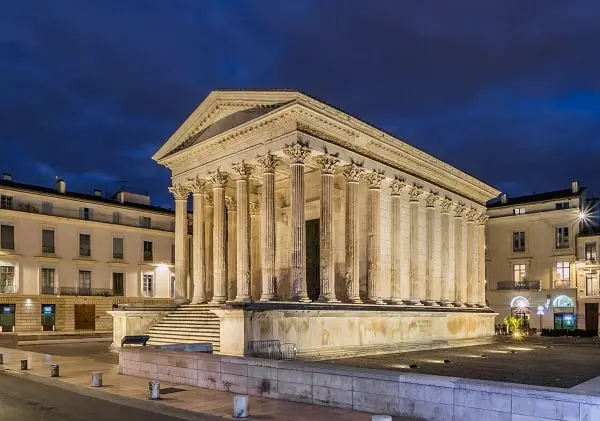
Maison carrée, which translates to square house, is one of the best-preserved Roman temples worldwide.
Situated in the city of Nîmes in southern France, the temple was built between 20 and 12 BC.
The temple is a classic Vitruvian architectural illustration with a substantially sizeable rectangular building raised on a high podium through a flight of stairs.
The exterior of the building is lined with Corinthian columns, six free-standing columns in the front, and twenty engaged columns on the sides.
This temple that dominated the Forum was dedicated to the grandsons and adopted heirs of the first emperor of Rome, Augustus.
Gaius Caesar and Lucius Caesar both died at a young age and French archeologist Jean-François Séguier reconstructed the inscription regarding the temple’s dedication to them.
Maison carrée has been reconstructed significantly over the years, and no ancient decor remains inside the temple’s cella.
The large complex of adjoining buildings around the temple was brought down from 1821 to 1907 AD.
The ceiling was replaced, and the pronaos was restored during the 19th century. Further restorations were conducted between 1988-1992 AD.
Restorations continued, the most recent being conducted from 2006 to 2011 AD. The stunning temple remains one of France’s most intact and well-known archeological sites.
2. Baalbek temple
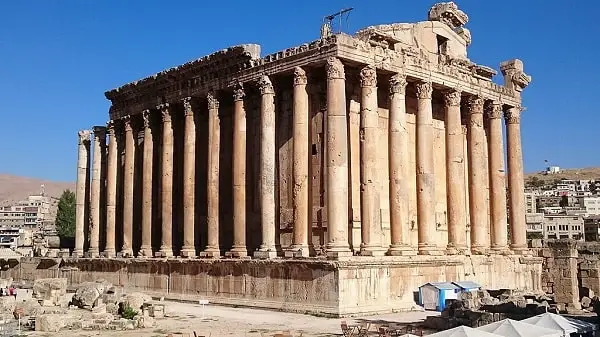
The city of Baalbek in Lebanon houses the Baalbek temple complex that initially comprised three Roman temples.
These temples, namely the Temple of Jupiter, the Temple of Bacchus, and the Temple of Venus, were constructed from the 1st century BC to the early 3rd century BC.
The Temple of Jupiter is a colossal edifice constructed on a raised podium and encircled by 54 Corinthian columns. The temple’s dedication was towards Jupiter, the Roman god of the sky.
This stunning building underwent gradual destruction through earthquakes, pillage for stones, and falling and removing the columns.
There has been no recorded restoration of the temple, and at present, 6 of its still-standing columns are the only remains of this grand Roman temple.
The Temple of Bacchus was constructed in the 190s during the reign of the emperor Lucius Septimius Severus.
It is the best-preserved temple in the complex, with some beautiful reliefs from the classical antiquity period.
Encircling the superstructure are 42 columns which were probably rounded and decorated after their placements. The temple was dedicated to Bacchus or Dionysus, the god of wine and pleasure.
The building did face some minor destructive instances but was re-supported and preserved.
The Temple of Venus, also called the Circular Temple, was completed in the early 3rd century under the rule of Lucius Septimius Severus again.
The temple was dedicated to Venus, the Roman goddess associated with love and beauty.
Constantine then demolished it and built a basilica where it stood.
The Temple of Bacchus is the best-preserved archeological monument among the Baalbek temples. Next comes the ruins of the Temple of Jupiter, with a few of its original columns still standing.
The Temple of Venus did not survive. This complex is one of the major tourist attractions in Lebanon.
1. Pantheon

The Pantheon stands as the best-preserved monument from ancient Rome in the city of Rome in Italy.
It was constructed on the site of a previously commissioned temple during the reign of Caesar Augustus, the first Roman emperor.
It was rebuilt during Hadrian’s rule, the date of which remains unclear.
The temple was dedicated to the Pantheon; twelve Olympians were considered the principal deities in Greek mythology.
It is a cylindrical building standing on a circular footprint with Corinthian columns lining up on the front porch.
The interior of the building is exquisitely designed, comprising a concrete dome with an oculus. Contrary to the somewhat plain exterior, the interior is decorated with colorful marbles lining the walls and rectangular coffers cut on the ceiling.
In 609 AD, Phocas, a Byzantine emperor, let Pope Boniface IV have the building, converting it to a Catholic church and dedicating it to St. Mary and the Martyrs.
The consecration of the building is the key reason behind its preservation, as it was constantly in use and didn’t face the situation of abandonment and obliteration.
Since the Renaissance period, several vital burials have taken place in the Pantheon.
In 1946, after the monarchy was abolished, republican authorities refused to grant permission for any other burials at the site.
At present, Pantheon operates as a church, and visitors must maintain a demeanor level. The stunning archeological site is still breathtaking almost 2000 years after its construction.
The famous ancient building has managed to influence a few modern architectural structures.
The Jefferson Memorial in Washington, D.C., is one of the latter-day buildings whose design and depiction are based on the Pantheon.
This influence was seen due to Thomas Jefferson’s inclination towards classical architecture, in honor of whom the memorial was built.
Conclusion
These Roman temples in many different parts of the world signify Rome’s ancient art and culture. They represent the unique style and designs used during the construction of the buildings in ancient Rome, and the most known temples besides the ones mentioned above include the Temple of Caesar and the Temple of Saturn.
To this day, the archeological sites that include a well-preserved or partly-preserved Roman temple attract many tourists.
These temples have provided much relevant information related to ancient Rome and civilization during that period. Archeological studies of the ancient Roman temples have mostly proved practical and informative.
